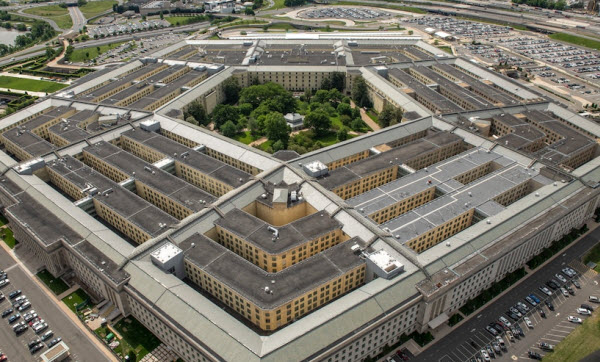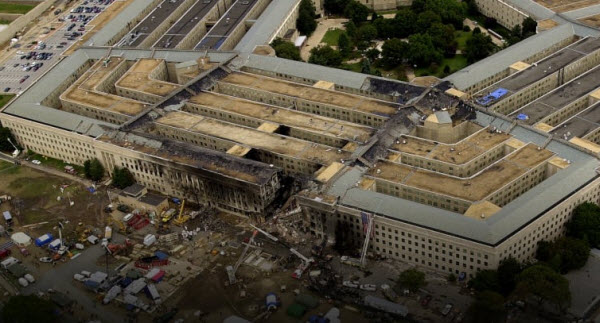The Pentagon is the headquarters of the United States Department of Defense. This massive, five-sided building, made of concrete and steel, stands as a symbol of American military strength. Construction of the Pentagon began during World War II in Arlington County, Virginia, near the nation’s capital, Washington, D.C. The building occupies an extensive 150-acre site (about 60 hectares), making it the largest office building in the world. The Pentagon houses approximately 23,000 military and civilian personnel, as well as 3,000 non-defense support staff, distributed across five above-ground floors, two basement levels, and five concentric rings of corridors, totaling 28.2 kilometers in length. The central courtyard, often referred to as “Ground Zero,” is considered a potential primary target in the event of a nuclear war. Since its construction, the Pentagon has faced no significant threats except for the September 11 attacks, when a hijacked plane crashed into one side of the building, resulting in the deaths of 189 people and causing extensive damage to one-third of the structure.
The History of the Pentagon Building
On May 27, 1941, just three weeks after Germany’s surprise attack on the Soviet Union, President Franklin D. Roosevelt declared a national emergency. World War II was at its height, and Nazi Germany, under Adolf Hitler’s leadership, had already occupied much of Europe. The U.S. War Department was operating at full capacity, with nearly 24,000 people spread across 17 buildings in Washington, D.C. As the war progressed, it was expected that this number would increase to 30,000 by the following year. In response, President Roosevelt personally approved the construction of a new military facility in the Foggy Bottom neighborhood of the city, with an estimated cost of $18 million, and planned to open in June 1941. However, by that time, the building had become too small (it later became the headquarters of the U.S. State Department in 1947).
To address this issue, General George Marshall, the Army Chief of Staff, turned to Brigadier General Brehon Somervell, head of the Army’s construction division. Somervell proposed an ambitious idea: a large headquarters capable of accommodating 40,000 people and covering 620,000 square meters of office space. Given the size of the proposed building, it was clear that it could not fit within Washington, D.C. limits, so Somervell selected a site across the Potomac River in Virginia, east of Arlington National Cemetery.
Under Somervell’s supervision, architect G. Edwin Bergstrom was tasked with designing the Pentagon. The location dictated the need for a five-sided, asymmetrical design. At the same time, Somervell insisted that the building should not exceed four stories to conserve steel, which was scarce due to the ongoing war, and to avoid obstructing the view of Washington, D.C., for local residents. On July 28, 1941, the House of Representatives approved the necessary legislation for the project, followed by the Senate on August 14. However, controversy soon arose over the building’s size and its proximity to the hallowed grounds of Arlington National Cemetery. Bowing to opposition pressure, President Roosevelt announced that the project should be moved to another nearby location, adjacent to Washington Hoover Airport, and instructed Somervell to reduce the building’s size slightly.

With the new site, known as Hell’s Bottom, architect Bergstrom found it easier to create a symmetrical five-sided design, incorporating multiple concentric pentagons interconnected by corridors and surrounding a central courtyard. The design also drew inspiration from traditional fortresses and Civil War-era fortifications. Construction of the Pentagon began on September 11, 1941. By early December, 3,000 workers were on site, led by Colonel Leslie Groves, who would later head the Manhattan Project to build the atomic bomb dropped on Hiroshima and Nagasaki. Despite the intense effort, the project was behind schedule.
On December 7, Japan attacked Pearl Harbor, prompting the United States to formally enter the war. This event allowed Somervell to expand the project, lifting earlier construction constraints and working on a larger building. By March 1942, more than 10,000 people were working on the site. At one point, the workforce swelled to 15,000, working in three shifts around the clock, with some shifts continuing under floodlights at night. The first Pentagon employees moved into the building on April 30, 1942, and the building was officially opened on January 14, 1943, with an initial cost of $35 million. However, during construction, costs rose to $75 million, with some estimates suggesting even higher figures.
Post-War Developments and the Pentagon’s Role
After World War II ended, many questioned what to do with the Pentagon. The prevailing opinion was that the War Department would not need such a large building in peacetime. Suggestions ranged from converting it into a hospital, a university, or a veterans’ administration headquarters. However, the U.S. Army had no intention of relinquishing it. In September 1947, Congress passed the National Security Act, leading to the largest military reorganization in American history. This act restructured the military establishment, separated the Air Force from the Army, established the Joint Chiefs of Staff, and created the Central Intelligence Agency (CIA) and the National Security Council. As a result, the Pentagon became the nerve center of U.S. military operations during the Cold War, as the wartime alliance with the Soviet Union disintegrated into a fierce rivalry fueled by the nuclear arms race and growing U.S. security commitments worldwide.

To consolidate the military’s command structure, President Harry Truman wanted the Navy, Army, and Air Force headquarters to be located in the Pentagon. James Forrestal, the nation’s first Secretary of Defense, was tasked with this massive undertaking. While Forrestal is often remembered as the “godfather” of the national security state, the immense pressure from the job exacerbated his mental illness. Showing signs of severe deterioration, Truman replaced him with Louis Johnson in January 1949. Forrestal suffered a nervous breakdown and, four months later, took his own life. Despite this tragic start, the military establishment continued to solidify its position, especially after August 1949, when the Soviet Union detonated an atomic bomb in Siberia. Truman signed a law granting the Secretary of Defense full authority over the armed forces and renaming the National Military Establishment as the Department of Defense.
The Pentagon in Modern Times
Following North Korea’s invasion of South Korea in June 1950, the Pentagon’s workforce grew to its peak, eventually reaching 33,000 employees. By the end of the Korean War, the building had become a tourist attraction, with people wandering its grounds and inner courtyard, marveling at its immense size. It became an unmistakable symbol of America’s growing military dominance worldwide, a development that many Americans celebrated.

During the extensive U.S. military deployment in 1990, Operation Desert Storm in the Gulf War highlighted the need to update the Pentagon’s aging infrastructure, which had been declared a National Historic Landmark in 1992. Renovation and restoration began in October 1994 after Congress approved over $1 billion for the effort. The renovation project exceeded its original timeline and budget, particularly after increased security measures were implemented following the 1998 bombings of U.S. embassies in Kenya and Tanzania.
Notable Events at the Pentagon
Throughout its history, the Pentagon has witnessed several memorable events, both peaceful and violent. These events have been recorded and documented in the annals of history:
- Vietnam War Protests in the 1960s: On October 21, 1967, during the peak of the U.S.’s controversial involvement in the Vietnam War, approximately 35,000 anti-war protesters gathered around the Lincoln Memorial and marched across the Memorial Bridge toward the Pentagon. Meanwhile, more than 2,000 federal troops armed with tear gas gathered inside the building. When the crowd surged toward the Pentagon, the soldiers met them with bayonets fixed to their rifles, and violence erupted. By the time the last protesters were arrested, the defending troops had successfully completed their mission without firing a single shot or causing any fatalities. However, the incident further strained relations between anti-war protesters and the government. In May 1972, an anti-war group planted a bomb in a women’s restroom in the Pentagon, which exploded at 1 a.m. Fortunately, no one was injured, but the blast caused about $75,000 in damage.

- September 11 Attacks: On September 11, 2001, renovations were in their final stages at the Pentagon. On that day, shortly after the attack on the World Trade Center in New York City, American Airlines Flight 77 crashed into the western wall of the Pentagon’s first floor at 9:37 a.m. The hijacked plane was traveling at a speed of 850 kilometers per hour when it struck, causing severe damage 27.5 meters wide and 9 meters deep, penetrating the building’s three outer rings. The resulting fire burned for 36 hours, and by the time it was extinguished, 189 people had died, including 125 Pentagon workers and 64 people on the plane (including the five hijackers).Following the attack, a $501 million repair and renovation initiative, named the “Phoenix Project,” was launched. In early October 2001, the project’s leader, Lee Evey, announced the goal of completing repairs by September 11, 2002. Meanwhile, work inside the building continued at a brisk pace to pursue Al-Qaeda in Afghanistan and prepare for the upcoming war in Iraq. The Phoenix Project was officially completed in February 2003, with a total cost of about $5 billion.

